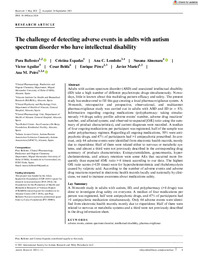Title:
The challenge of detecting adverse events in adults with autism spectrum disorder who have intellectual disability |
Authors:
Ballester, Pura 
Espadas, Cristina
Londoño, Ana C.
Almenara, Susana
Aguilar, Víctor 
Belda, César
Pérez, Enrique
Muriel, Javier 
Peiró, Ana  |
Editor:
Wiley |
Department:
Departamentos de la UMH::Farmacología, Pediatría y Química Orgánica |
Issue Date:
2021-05 |
URI:
https://hdl.handle.net/11000/32363 |
Abstract:
Adults with autism spectrum disorder (ASD) and associated intellectual disability (ID) take a high number of different psychotropic drugs simultaneously. Nowadays, little is known about this multidrug pattern efficacy and safety. The present study has endeavored to fill this gap creating a local pharmacovigilance system. A 36-month, retrospective and prospective, observational, and multicenter pharmacovigilance study was carried out in adults with ASD and ID (n = 83). Information regarding ongoing medications (polypharmacy: taking simultaneously >4 drugs; safety profile: adverse events' number, adverse drug reactions' number, and affected system; and observed-to-expected [O/E] ratio using the summary of product characteristics), and current diagnoses were recorded. A median of four ongoing medications per participant was registered, half of the sample was under polypharmacy regimen. Regarding all ongoing medications, 50% were antipsychotic drugs, and 47% of participants had >1 antipsychotic prescribed. In contrast, only 64 adverse events were identified from electronic health records, mostly due to risperidone. Half of them were related either to nervous or metabolic systems, and almost a third were not previously described in the corresponding drug summary of products characteristics. Extrapyramidalism, gynecomastia, hypercholesterolemia, and urinary retention were some AEs that occurred more frequently than expected (O/E ratio > 6 times) according to our data. The highest O/E ratio scores (>120 times) were for hypercholesterolemia and rhabdomyolysis caused by valproic acid. According to the number of adverse events and adverse drug reactions reported in electronic health records locally and nationally by clinicians, we need to increase awareness about medications safety. LAY SUMMARY: A 36-month study in adults with autism, ID, and polypharmacy (>4 drugs) was done to investigate drug safety on everyone. A median of four medications per person was registered, half were antipsychotic drugs, and 47% of participants had >1 antipsychotic medication simultaneously. Only 64 adverse events were identified from electronic health records, mostly due to risperidone. Half of them were related to nervous or metabolic systems and a third were not previously described in the drug information sheet.
|
Keywords/Subjects:
adverse events
autism spectrum disorder
intellectual disability
pharmacovigilance |
Knowledge area:
CDU: Ciencias aplicadas: Medicina: Farmacología. Terapéutica. Toxicología. Radiología |
Type of document:
info:eu-repo/semantics/article |
Access rights:
info:eu-repo/semantics/openAccess |
DOI:
https://doi.org/10.1002/aur.2624 |
Published in:
Autism Research . 2022 Jan;15(1):192-202 |
Appears in Collections:
Artículos Farmacología, Pediatría y Química Orgánica
|

.png)
